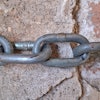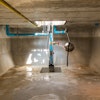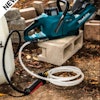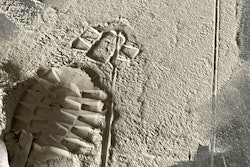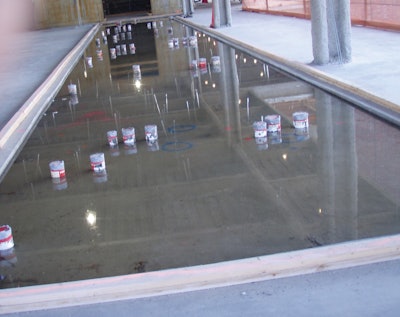
Introduced in the 1970s, F-Numbers have proven to be useful in measuring and improving concrete floor flatness and levelness. F-number measurements are standardized under ASTM E 1155 "Standard Test Method for Determining FF Floor Flatness and FL Floor Levelness Numbers" and cited in ACI 301 "Specifications for Structural Concrete." While the use of F-numbers has been successful there are some limitations that specifiers should consider when specifying F-numbers for the following floors:
- Multiple obstructions to finishing operations
- Broom finish
- Construction joints
ACI 302.1R-04 "Guide for Concrete Floor and Slab Construction" provides F-number recommendations for hard-troweled slabs-on-ground and suspended slab surfaces. But they do not provide guidance for floors described above.
Multiple obstructions to finishing operations
Getting a floor flat and level takes the proper procedures and equipment and space to use them. For some projects, floor penetrations and projections are too numerous and too concentrated to permit use of:
- Conventional straightedge strikeoff methods with vibratory truss or hand screed resting on pipe rails;
- 10 foot (3 m) scraping straightedges; or
- Ride-on power trowels. Sometimes such areas are so congested that a walk-behind power trowel has limited access.
Such projects require strikeoff, floating and subsequent troweling to be done by hand.
Flatness measurements made in accordance with ASTM E 1155 must be taken along lines no closer than 2 feet (0.6 m) from any penetration. Measuring lines can still be snaked through the areas with multiple penetrations, but F-numbers are nearly always low in areas where this is done because of the hand work that produced the surface flatness. In areas with multiple penetrations that restrict the use of strikeoff equipment, 10 foot (3 m) straightedges and ride-on power trowels, specifiers should limit maximum F-numbers to those typically produced with conventional bullfloats (see ACI 117-10, Table 4.8.5.1).
The American Society of Concrete Contractors (ASCC) position statement #25 "Floor Finish Specifications" (published in ACI's Concrete International in January 2005 and available at www.ascconline.org) brings attention to this issue by letting specifiers know that F-numbers should be lowered when there is not space for the procedures and equipment used to obtain higher F-numbers.
Broom finish
ACI 302.1R does not provide any recommendations on F-numbers for broomed surfaces. Some specifiers are requiring overall and local F-numbers for surfaces they require to be bullfloated and broomed for parking garages, parking lots and other surfaces requiring a texture that improves slip resistance. In most instances the specified F-numbers are not achievable.
ACI 117-10 "Specification for Tolerances for Concrete Construction and Materials" states that the use of only a conventional bullfloat can achieve an overall FF of 20. Local minimum values are set at three-fifths of the overall values. Since the broom is used after the bullfloat and makes the surface rougher, the flatness would be expected to decrease below an FF 20. Unfortunately, specifiers usually require an overall FF of 20 and sometimes as high as 35 for a broom finish surface. These floor flatness requirements are unlikely to be met with a broom finish.
In 2011, Baker Concrete Construction at their Monroe, Ohio, headquarters replaced a section of exterior pavement in which they provided a light, medium and heavy broom finish. Flatness was measured in accordance with ASTM E 1155 within 24 hours after the concrete was broomed. Even though the sections were designated as light, medium and heavy broom, the variations in measured flatness were the same: Measured FF values were between 15 and 20.
Based on the measurements at Baker's office and measurements we've made on other broomed surfaces, the overall FF values above 15 should be not be specified. Alternatively, specifiers should refer to ACI 330.1-03 "Specifications for Unreinforced Concrete Parking Lots" which does not use F-numbers but recommends a ½-inch gap under a 10-foot unleveled straightedge.
Construction joints
F-numbers are measured in accordance with the restrictions set forth in ASTM E 1155. One important restriction is that when testing a floor, no test section boundary shall cross any construction joint. As ASTM E 1155 states in Note 4, shown below, traffic usually crosses many construction joints.
NOTE 4—Since construction joints are a discontinuity in the floor surface, measuring across them would introduce statistical anomalies into this test method. Construction joints are therefore excluded from the generation of F-Number statistics. However, since traffic will nevertheless pass across many of the construction joints, a separate measurement and analysis of the joints may be required in order to provide a quantitative measure of the roughness of the joints themselves. Some joints may never see traffic, for example, those along a wall. The particular joints required to be analyzed may be specified in contract specifications, along with a maximum allowable value for qi.
However, in addition to forklift traffic, floor coverings must also cross construction joints. When using sheet vinyl tile over construction joints, a line above the tile that mirrors the joint below is sometimes noticeable. In an attempt to remedy this issue, specifiers are requiring sample measurement lines to be run across the construction joint.
However, section 7.7 of ASTM E 1155 has a provision for separately measuring across construction joints.
7.7 Construction Joints—Where construction joints are required to be measured, periodic measurements of the 24-in. curvature qi shall be taken, transverse to and centered on the construction joint. At least one qi measurement shall be taken on each straight section of joint, with a maximum interval between measurement locations not to exceed 10 ft. These measurement locations shall be recorded.
As Note 4 indicates, construction joints are excluded from the sample measurement lines when obtaining F-numbers for random floors. Measuring across construction joints lowers the F-number values for the entire floor.
Specifiers have decided to ignore ASTM E 1155 and use the Project Specifications to void it by requiring that sample measurement lines cross construction joints when obtaining F-numbers on random traffic floors. This in effect lowers the F-numbers for the floor and subjects the contractor to remediation or payment penalty requirements for the entire floor when there may only be an issue at the construction joint.
Consider for example a floor that measures an FF 68 and an FL 30. What happens if the sample measurement line runs across a 1/8-inch elevation change at the construction joint? Based on ASTM E 1155 calculations, the FF and FL reduce to 41 and 25. And if the construction joint elevation changes by 1/4 inch, the FF is 22 and FL 21.
Specifers should follow ASTM recommendations and separate the measurement of construction joints from the random traffic floors. However, if the sample measurement line crosses the construction joint, the specification limits for F-numbers should be reduced.
